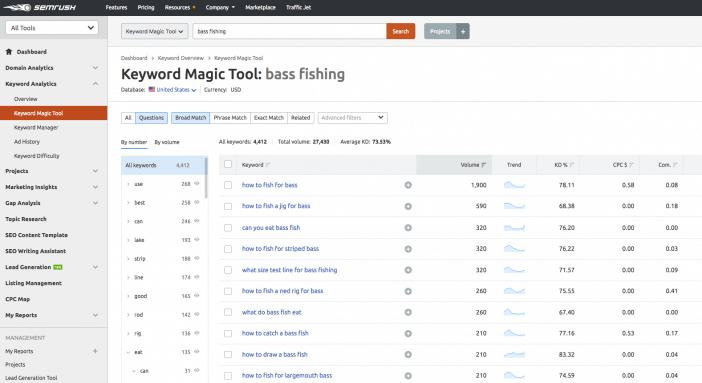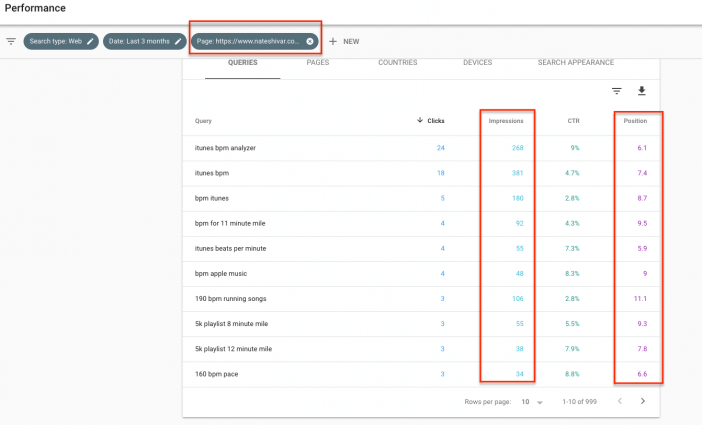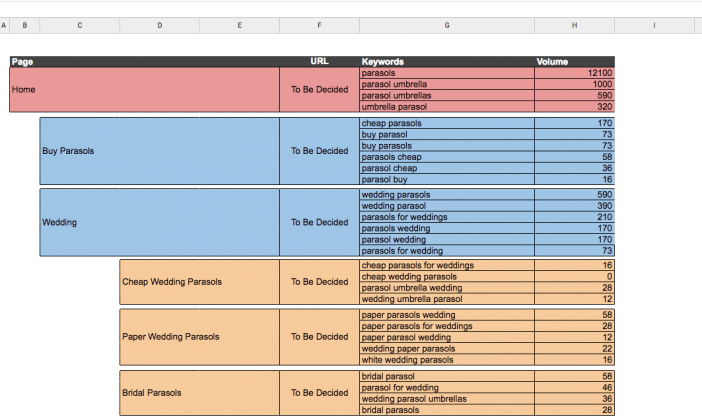Anyone who owns a website and recognizes the opportunity to get visitors from Google organic search suspects the importance of keywords.
If you can appear in those results when someone types in a certain keyword – that’s not only a visitor…but a highly qualified, free visitor.
But how do you use those keywords on your website to actually get traffic?
Put them in the meta=”keywords”? Use them over and over on your site?
Note: nothing against Bing, but I’ll be using “search engine” and “Google” interchangeably in this post
It’s been more than 15 years since simply using keywords on your website was the only way for search engines to understand the relevance of your website. It’s no longer about just stuffing keywords all over your site. Search engines have gotten much smarter.
Google and Bing use hundreds of signals to try to decipher and rank the relevance of your website. They factor in what other people say about your site; they try to place your content in a graph of topics and entities, and perform all sorts of semantic analysis.
But keywords are still part of the foundation of how search engines understand your website.
Using keywords effectively on your website will help you tell a better story to both your visitors and search engines, and it will help communicate what searches your website is relevant for…so that you can get more visitors from search engines.
Here’s how to use keywords on your website with what is known in the SEO (search engine optimization) industry as a “keyword map.”
1. The End Goal
Using keywords on your site isn’t about trying to trick Google, or pander to Google for Google’s sake.
It’s about matching the language on your site to the language that your customers use when they search for you.
We do this to an extent in real life, but don’t realize it because it’s normal and natural.
For example, a plumber doesn’t take out a billboard announcing that they will “fix all your sillcocks!”
Instead, the plumber announces that they can “fix all your outdoor faucets!”
Same service – different language.
Keywords are simply how people search for your product or service. Your end goal is to help your customer find what they are looking for.
Google is just the intermediary between you and your customer. The goal of SEO and the effective use of keywords is to help Google understand your site to increase your search engine visibility.
However, you have to keep in mind that Google is not stupid. Google is going to catch any attempt to deceive or manipulate.
But Google is not a human, and it’s not your customer. Google loves SEO when done well. It makes their job easier.
Your goal with understanding how to use keywords on your site is to help Google understand what your website – and each page on your site – is about…so that customers searching through Google can find what they are looking for.
Again: your goal is to help the person searching by helping the search engines – not trying to trick, spam or manipulate the person searching by spamming the search engines.
2. Understand The Concept
Search engines want to serve up relevant results with unique content to their customers. Your goal with your website is to provide the pages that Google wants to serve as those relevant results.
This means several things in practice when you’re deciding on how to use keywords for SEO on your website.
First, you aren’t using keywords on your website so much as you are using certain keywords on individual pages.
Google is going to serve up individual pages in search results – which means that you are ultimately optimizing individual pages. Your site will be optimized by optimizing the individual pages.
Second, instead of thinking in terms of individual keywords, think in terms of themes of keywords. A single page will be about a single topic, which can then be described with several keywords.
When you have several pages about specific topics, and they are all optimized for a theme of keywords, then your site as a whole is going to be relevant for not just a single keyword, but a full range of keywords.
But all that is abstract. Here’s an example. Suppose you want to build a website that ranks for “dining room furniture.”
It’s not enough to just focus on “dining room furniture” – you can’t prove your website’s relevance by just using “dining room furniture” everywhere. That’s old idea of “keyword density.”
You have to be the site that you would rank if you were trying to find the most relevant dining room furniture site on the Internet.
A site like that would not just have a page (maybe the homepage) that talks about dining room furniture in general, but I would also expect it to have a page about dining room chairs, and dining room tables. It would probably have pages about how to decorate a dining room. It might have pages about table centerpieces, rugs, placemats, maybe hutches.
All your keywords work together to tell the full story of your site. What is it about? How is it relevant? You want to use a single keyword theme per page to help Google understand exactly what each page is about and how it relates to the whole.
Keep that concept in mind while you are trying to fit keywords and your site together.
3. Make Your Map
Once you have the concept and your end goals in place, we can start “mapping keywords” to pages. This step is important because it will help you avoid duplicating keyword themes. It will also help you see all your site’s parts, architecture, and how they work together to create your whole site.

I typically create my maps in Google Spreadsheets or Excel. You’ll be re-creating your website’s pages on rows and using columns for headers.
In the far left column, put each page’s name. I usually use multiple columns to create a hierarchy of pages, with each subpage indented in by 1 column.
In the next column over, put the page’s URL so that you’ll know exactly what page you’re referring to (you also may catch a bit of content that doesn’t make sense, or can be consolidated).
You’ll then have a column for your keyword list, which you’ll be assigned to each page. I’ll also put a final column where I can put the local search volume numbers given by Google (find with a free Ads account under Google Keyword Planner) or given by your paid keyword search tool. Try either of these two –
- For best the best data, go try SEMrush’s keyword research tool for free for 14 days.
- For a solid budget option, go try KWfinder by Mangools for free for 14 days.
If you’re in a very competitive industry, then I’d also put a few additional columns. Those additional columns would include –
Primary Keyword / Focus Keyword – This is your main keyword phrase that describes topic that the page covers. It will likely show up in your title tag or headline. It usually relates to “head keywords” – something broad but descriptive.
Keyword Difficulty – This is a score provided by your keyword tool to help you judge how competitive a search query / search term is. The goal of this column is also to allow you to quickly judge a keyword’s value when you start actually using your keyword map (ie, more volume = more value typically, which has to be balanced against competitiveness).
Secondary Keywords – This column has several relevant keyword options that complement your target keyword. They will usually show up in section headings on your blog content or landing page. They will usually relate to a set of “long tail keyword” where you also hope to show up for in the search result.
Related Keywords -This column will have specific keyword variants that you should use for keyword optimization. Some SEOs refer to “LSI Keywords” which is an old, and basic concept that lots of words are likely to appear together. If you are writing about a hammer, you should be sure to mention a nail somewhere. It’s less about keyword stuffing and more about remembering to be detailed, descriptive, and comprehensive.
4. Define Your Page’s Relevance & Value
Now that you have all the pages of your site in front of you, then you can start to look at them individually, and then as a whole. Before you start researching keyword ideas for each page, define what questions each page answers and what topics it is relevant for.
Does the page really help anyone?
Play Jeopardy with your pages – your pages are the answer, and you have to write the question.
This process doesn’t have to be tedious or time-consuming. Instead, it’s a check to make sure that you are providing the value that you think you are providing so that you don’t approach keyword research with preconceived notions or rose-tinted glasses.
Again, be the result that Google would want to rank. Are your pages helping people find what they are looking for?
5. Do Your Keyword Research
This step will be the 2nd part in this On-Page SEO series. But the short version is that you’ll take #3 and start brainstorming keywords that people would use to search for your site. There are plenty of methods here.
You can use Google Ad‘s Keyword Planner (usually used for Google Ads Keyword Research), but also useful for SEO.
You can use other lesser-known tools to find keywords worth targeting.
If you have some budget, paid tools like SEMrush and KWfinder by Mangools can help. They have enormous keyword databases that can dramatically improve your keyword research.

If your website has been around for a while, you can also use the Search Queries report in Google Search Console to see how Google currently understands your webpages.
Go to Google Search Console –> Performance, then click the drop down of each page. You’ll see a list of keywords that the page is currently relevant for.

But even after you’ve got your full list of keywords to target (and their search volumes from the Keyword Planner), the key part of this step is to bucket them into keyword themes.
For example, if you run a baseball site, a theme of keywords might consist of youth baseball bats, little league bats, junior baseball bats, and bats for little league.
These keywords all revolve around the same theme, and allow you to write content that is natural, not-spammy, but also clearly indicate what how your page is relevant to a certain keyword or topic. Read the full guide to keyword research here.
6. Assign Keywords to Pages
At this step, you’ll take your keyword themes (from #4), look at your notes from #3 about what pages are relevant for what topics, and place your keywords into the keyword column of the map you created in #2.
Place the keywords in descending order based on search volume seen in the Keyword Planner, or some other gauge of priority, so that you can quickly judge which keywords represent a bigger opportunity.
You’ll end up with something that looks like this –

You can target as many keywords as you want to a page, but keep in mind that you’ll actually have to use the keyword to target it. That said, any list beyond 6 or 7 on a page can get unwieldy and any list with only 1 or 2 can get spammy (ie, using the same keyword over and over).
7. Do Quality Assurance
Once you have your keyword map completed, look at the keywords assigned to each page.
If someone unfamiliar with your website could see just those keywords, could they tell you exactly what each page is about? Could you give someone your keyword map and ask them to write content about it?
Do all the keywords associated with each page go with each other? Should you break up pages?
Are there any themes that are very similar? Are they similar enough to merge the pages?
Often simply taking the time to map your website will help you see the bigger picture of your website and how you can make it easier to understand for both users and search engines.
8. Create an On Deck Map & Move to Creating Meta Data
In the American sport of baseball, there’s a term for person who isn’t playing yet, but is the next batter up – the “on deck hitter.” He’s in the game, but not yet playing.
During your keyword research, you’ll probably find plenty for keywords that are related to your site, but don’t quite fit any page currently on your site. Don’t delete them.
Instead, go ahead and put them into themed buckets, and designate them as your “on deck” keywords. They don’t have a role to play in your site as it currently is. However, they are keywords that should be used for any future pages (or blog posts) on your site.
Now that you have your keyword map complete, and a list of how you are going to use keywords on your site, it’s time to actually use them on your website.
The first and most important place to use your keywords is the “metadata” of each page – consisting of the title tag and meta description.
But you’re next step is to open Google Docs or Microsoft Excel and start mapping your website.
Check out SEMrush’s keyword research tool for free here or KWfinder by Mangools here.




Do you mind if I quote a couple of your articles as long as I provide credit and
sources back to your blog? My blog is in the exact same niche as yours and my visitors would truly benefit from some of the information you provide here.
Please let me know if this ok with you. Many thanks!